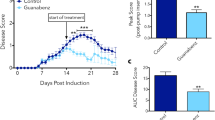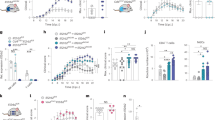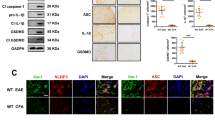Abstract
The molecular mechanisms that link the sympathetic stress response and inflammation remain obscure. Here we found that the transcription factor Nr4a1 regulated the production of norepinephrine (NE) in macrophages and thereby limited experimental autoimmune encephalomyelitis (EAE), a mouse model of multiple sclerosis. Lack of Nr4a1 in myeloid cells led to enhanced NE production, accelerated infiltration of leukocytes into the central nervous system (CNS) and disease exacerbation in vivo. In contrast, myeloid-specific deletion of tyrosine hydroxylase (TH), the rate-limiting enzyme in catecholamine biosynthesis, protected mice against EAE. Furthermore, we found that Nr4a1 repressed autocrine NE production in macrophages by recruiting the corepressor CoREST to the Th promoter. Our data reveal a new role for macrophages in neuroinflammation and identify Nr4a1 as a key regulator of catecholamine production by macrophages.
This is a preview of subscription content, access via your institution
Access options
Subscribe to this journal
Receive 12 print issues and online access
$209.00 per year
only $17.42 per issue
Buy this article
- Purchase on SpringerLink
- Instant access to full article PDF
Prices may be subject to local taxes which are calculated during checkout





Similar content being viewed by others
References
Cosentino, M. & Marino, F. Adrenergic and dopaminergic modulation of immunity in multiple sclerosis: teaching old drugs new tricks? J. Neuroimmune Pharmacol. 8, 163–179 (2013).
Gold, S.M. et al. The role of stress-response systems for the pathogenesis and progression of MS. Trends Immunol. 26, 644–652 (2005).
Arima, Y. et al. Regional neural activation defines a gateway for autoreactive T cells to cross the blood-brain barrier. Cell 148, 447–457 (2012).
Brosnan, C.F. et al. Prazosin, an alpha 1-adrenergic receptor antagonist, suppresses experimental autoimmune encephalomyelitis in the Lewis rat. Proc. Natl. Acad. Sci. USA 82, 5915–5919 (1985).
Brosnan, C.F., Sacks, H.J., Goldschmidt, R.C., Goldmuntz, E.A. & Norton, W.T. Prazosin treatment during the effector stage of disease suppresses experimental autoimmune encephalomyelitis in the Lewis rat. J. Immunol. 137, 3451–3456 (1986).
Dimitrijević, M. et al. Beta-adrenoceptor blockade ameliorates the clinical course of experimental allergic encephalomyelitis and diminishes its aggravation in adrenalectomized rats. Eur. J. Pharmacol. 577, 170–182 (2007).
Maxwell, M.A. & Muscat, G.E. The NR4A subgroup: immediate early response genes with pleiotropic physiological roles. Nucl. Recept. Signal. 4, e002 (2006).
Campos-Melo, D. et al. Repeated immobilization stress increases nur77 expression in the bed nucleus of the stria terminalis. Neurotox. Res. 20, 289–300 (2011).
Chan, R.K., Brown, E.R., Ericsson, A., Kovacs, K.J. & Sawchenko, P.E. A comparison of two immediate-early genes, c-fos and NGFI-B, as markers for functional activation in stress-related neuroendocrine circuitry. J. Neurosci. 13, 5126–5138 (1993).
Helbling, J.C., Minni, A.M., Pallet, V. & Moisan, M.P. Stress and glucocorticoid regulation of NR4A genes in mice. J. Neurosci. Res. 92, 825–834 (2014).
Malkani, S. & Rosen, J.B. Induction of NGFI-B mRNA following contextual fear conditioning and its blockade by diazepam. Brain Res. Mol. Brain Res. 80, 153–165 (2000).
Hamers, A.A. et al. Bone marrow-specific deficiency of nuclear receptor Nur77 enhances atherosclerosis. Circ. Res. 110, 428–438 (2012).
Hanna, R.N. et al. NR4A1 (Nur77) deletion polarizes macrophages toward an inflammatory phenotype and increases atherosclerosis. Circ. Res. 110, 416–427 (2012).
Carlin, L.M. et al. Nr4a1-dependent Ly6Clow monocytes monitor endothelial cells and orchestrate their disposal. Cell 153, 362–375 (2013).
Hanna, R.N. et al. The transcription factor NR4A1 (Nur77) controls bone marrow differentiation and the survival of Ly6C- monocytes. Nat. Immunol. 12, 778–785 (2011).
Moran, A.E. et al. T cell receptor signal strength in Treg and iNKT cell development demonstrated by a novel fluorescent reporter mouse. J. Exp. Med. 208, 1279–1289 (2011).
Kaufman, S. Tyrosine hydroxylase. Adv. Enzymol. Relat. Areas Mol. Biol. 70, 103–220 (1995).
Bettelli, E. et al. Myelin oligodendrocyte glycoprotein-specific T cell receptor transgenic mice develop spontaneous autoimmune optic neuritis. J. Exp. Med. 197, 1073–1081 (2003).
Sedgwick, J.D. et al. Isolation and direct characterization of resident microglial cells from the normal and inflamed central nervous system. Proc. Natl. Acad. Sci. USA 88, 7438–7442 (1991).
Gautier, E.L. et al. Gene-expression profiles and transcriptional regulatory pathways that underlie the identity and diversity of mouse tissue macrophages. Nat. Immunol. 13, 1118–1128 (2012).
Jakubzick, C. et al. Minimal differentiation of classical monocytes as they survey steady-state tissues and transport antigen to lymph nodes. Immunity 39, 599–610 (2013).
Lee, S.L. et al. Unimpaired thymic and peripheral T cell death in mice lacking the nuclear receptor NGFI-B (Nur77). Science 269, 532–535 (1995).
Ajami, B., Bennett, J.L., Krieger, C., McNagny, K.M. & Rossi, F.M. Infiltrating monocytes trigger EAE progression, but do not contribute to the resident microglia pool. Nat. Neurosci. 14, 1142–1149 (2011).
Geissmann, F., Jung, S. & Littman, D.R. Blood monocytes consist of two principal subsets with distinct migratory properties. Immunity 19, 71–82 (2003).
Jung, S. et al. Analysis of fractalkine receptor CX(3)CR1 function by targeted deletion and green fluorescent protein reporter gene insertion. Mol. Cell. Biol. 20, 4106–4114 (2000).
Saederup, N. et al. Selective chemokine receptor usage by central nervous system myeloid cells in CCR2-red fluorescent protein knock-in mice. PLoS ONE 5, e13693 (2010).
Fan, Z. et al. In vivo tracking of 'color-coded' effector, natural and induced regulatory T cells in the allograft response. Nat. Med. 16, 718–722 (2010).
King, I.L., Dickendesher, T.L. & Segal, B.M. Circulating Ly-6C+ myeloid precursors migrate to the CNS and play a pathogenic role during autoimmune demyelinating disease. Blood 113, 3190–3197 (2009).
Mildner, A. et al. CCR2+Ly-6Chi monocytes are crucial for the effector phase of autoimmunity in the central nervous system. Brain 132, 2487–2500 (2009).
Yamasaki, R. et al. Differential roles of microglia and monocytes in the inflamed central nervous system. J. Exp. Med. 211, 1533–1549 (2014).
Aloisi, F. Immune function of microglia. Glia 36, 165–179 (2001).
Gilbert, F. et al. Nur77 gene knockout alters dopamine neuron biochemical activity and dopamine turnover. Biol. Psychiatry 60, 538–547 (2006).
Hnasko, T.S. et al. Cre recombinase-mediated restoration of nigrostriatal dopamine in dopamine-deficient mice reverses hypophagia and bradykinesia. Proc. Natl. Acad. Sci. USA 103, 8858–8863 (2006).
Nguyen, K.D. et al. Alternatively activated macrophages produce catecholamines to sustain adaptive thermogenesis. Nature 480, 104–108 (2011).
Gosselin, D. et al. Environment drives selection and function of enhancers controlling tissue-specific macrophage identities. Cell 159, 1327–1340 (2014).
Brown, S.W. et al. Catecholamines in a macrophage cell line. J. Neuroimmunol. 135, 47–55 (2003).
He, X.B. et al. Prolonged membrane depolarization enhances midbrain dopamine neuron differentiation via epigenetic histone modifications. Stem Cells 29, 1861–1873 (2011).
Sakurada, K., Ohshima-Sakurada, M., Palmer, T.D. & Gage, F.H. Nurr1, an orphan nuclear receptor, is a transcriptional activator of endogenous tyrosine hydroxylase in neural progenitor cells derived from the adult brain. Development 126, 4017–4026 (1999).
Yi, S.H. et al. Foxa2 acts as a co-activator potentiating expression of the Nurr1-induced DA phenotype via epigenetic regulation. Development 141, 761–772 (2014).
Andrés, M.E. et al. CoREST: a functional corepressor required for regulation of neural-specific gene expression. Proc. Natl. Acad. Sci. USA 96, 9873–9878 (1999).
Ballas, N. et al. Regulation of neuronal traits by a novel transcriptional complex. Neuron 31, 353–365 (2001).
Nowyhed, H.N. et al. The nuclear receptor nr4a1 controls CD8 T cell development through transcriptional suppression of runx3. Sci. Rep. 5, 9059 (2015).
Palumbo-Zerr, K. et al. Orphan nuclear receptor NR4A1 regulates transforming growth factor-beta signaling and fibrosis. Nat. Med. 21, 150–158 (2015).
Gaskill, P.J., Carvallo, L., Eugenin, E.A. & Berman, J.W. Characterization and function of the human macrophage dopaminergic system: implications for CNS disease and drug abuse. J. Neuroinflammation 9, 203 (2012).
Qiu, Y. et al. Eosinophils and type 2 cytokine signaling in macrophages orchestrate development of functional beige fat. Cell 157, 1292–1308 (2014).
Claudio, L. & Brosnan, C.F. Effects of prazosin on the blood-brain barrier during experimental autoimmune encephalomyelitis. Brain Res. 594, 233–243 (1992).
Goldmuntz, E.A., Brosnan, C.F. & Norton, W.T. Prazosin treatment suppresses increased vascular permeability in both acute and passively transferred experimental autoimmune encephalomyelitis in the Lewis rat. J. Immunol. 137, 3444–3450 (1986).
Flierl, M.A. et al. Phagocyte-derived catecholamines enhance acute inflammatory injury. Nature 449, 721–725 (2007).
Li, L. et al. Impeding the interaction between Nur77 and p38 reduces LPS-induced inflammation. Nat. Chem. Biol. 11, 339–346 (2015).
McMorrow, J.P. & Murphy, E.P. Inflammation: a role for NR4A orphan nuclear receptors? Biochem. Soc. Trans. 39, 688–693 (2011).
Saijo, K. et al. A Nurr1/CoREST pathway in microglia and astrocytes protects dopaminergic neurons from inflammation-induced death. Cell 137, 47–59 (2009).
Achiron, A., Feldman, A. & Gurevich, M. Characterization of multiple sclerosis traits: nuclear receptors (NR) impaired apoptosis pathway and the role of 1-alpha 25-dihydroxyvitamin D3. J. Neurol. Sci. 311, 9–14 (2011).
Achiron, A. et al. Microarray analysis identifies altered regulation of nuclear receptor family members in the pre-disease state of multiple sclerosis. Neurobiol. Dis. 38, 201–209 (2010).
Riol-Blanco, L. et al. Nociceptive sensory neurons drive interleukin-23-mediated psoriasiform skin inflammation. Nature 510, 157–161 (2014).
Sekiya, T. et al. The nuclear orphan receptor Nr4a2 induces Foxp3 and regulates differentiation of CD4+ T cells. Nat. Commun. 2, 269 (2011).
Jackson, C.R. et al. Retinal dopamine mediates multiple dimensions of light-adapted vision. J. Neurosci. 32, 9359–9368 (2012).
Bandukwala, H.S. et al. Selective inhibition of CD4+ T-cell cytokine production and autoimmunity by BET protein and c-Myc inhibitors. Proc. Natl. Acad. Sci. USA 109, 14532–14537 (2012).
Shaked, H. et al. Chronic epithelial NF-κB activation accelerates APC loss and intestinal tumor initiation through iNOS up-regulation. Proc. Natl. Acad. Sci. USA 109, 14007–14012 (2012).
Davalos, D. et al. Stable in vivo imaging of densely populated glia, axons and blood vessels in the mouse spinal cord using two-photon microscopy. J. Neurosci. Methods 169, 1–7 (2008).
Farrar, M.J. et al. Chronic in vivo imaging in the mouse spinal cord using an implanted chamber. Nat. Methods 9, 297–302 (2012).
Thornton, E.E., Krummel, M.F. & Looney, M.R. Live imaging of the lung. Curr. Protoc. Cytom. 60, 12.28.1–12.28.12 (2012).
Baxter, C.S., Andringa, A., Chalfin, K . & Miller, M.L. Effect of tumor-promoting agents on density and morphometric parameters of mouse epidermal Langerhans and Thy-1+ cells. Carcinogenesis 12, 1017–1021 (1991).
Wallace, K.L. & Linden, J. Adenosine A2A receptors induced on iNKT and NK cells reduce pulmonary inflammation and injury in mice with sickle cell disease. Blood 116, 5010–5020 (2010).
Acknowledgements
We thank D. Metzger (Institut Génétique Biologie Moléculaire Cellulaire) and H. Ichinose (Tokyo Institute of Technology) for Nr4a1fl/fl mice; K. Ley for discussions; A. Rao for guidance in composing the manuscript; A. Crotti for guidance on microglia culture; and D. Yoakum for assistance with mouse colony management. Supported by the American Heart Association (13SDG17060117 to I.S. and 12SDG12070005 to R.N.H.), the La Jolla Institute Board of Directors (R.N.H.), Fondation Leducq (M.U.K.), the Sigrid Juselius Foundation (M.U.K.), the Academy of Finland (M.U.K.), the Pacific Northwest Udall Center (P50-NS062684 to M.D.) and the US National Institutes of Health (R01 DK091183-21 to C.K.G. and R01 HL118765 to C.C.H.).
Author information
Authors and Affiliations
Contributions
I.S., R.N.H. and H.S. designed, performed and analyzed the experiments; G.C., H.N.N. and R.T. designed and preformed the experiments; G.T., R.T., A.B.B., Z.M., S.T., J.M., A.B., M.U.K., S.L.-W.-S. and A.R. performed the experiments; S.S.-A., M.D., G.D.T., A.B.-O., C.K.G., H.B. and C.C.H. designed the experiments; and I.S., R.N.H., H.S. and C.C.H. wrote the manuscript.
Corresponding authors
Ethics declarations
Competing interests
The authors declare no competing financial interests.
Integrated supplementary information
Supplementary Figure 1 EAE induction.
(a) Schematic of autoreactive 2D2 T cell stimulation, adoptive transfer and EAE disease induction in WT and Nr4a1–/– mice. (b) Flow cytometry analysis of TNFα and IFN-γ production in expanded and stimulated autoreactive 2D2 T cells prior to transfer. (c) CD64 and MerTK expression on macrophages and monocytes gated as in Main Fig. 1b.
Supplementary Figure 2 Loss of Nr4a1 leads to accelerated and exacerbated EAE.
(a) EAE progression following transfer of 0.5, 1 or 2 million autoreactive 2D2 T cells. Note that regardless of the number of injected cells, all mice eventually develop disease while Nr4a1–/– mice develop accelerated and worsened disease compared to their WT counterparts. p<0.01, p<0.001, p<0.001, respectively. (b) EAE progression following transfer of 1 million 2D2 T cells, monitored till the end point; note that WT mice eventually exhibit full disease progression, but in a significantly longer time compared to Nr4a1–/– mice. p<0.001. (c) Change in body mass percentage in WT and Nr4a1–/– mice with EAE progression following transfer of 0.5, 1 or 2 million 2D2 T cells. p<0.01, p<0.05, p<0.01, respectively. (d) EAE disease progression in WT and Nr4a1–/– mice after active immunization with MOG in complete Freund’s adjuvant. p<0.001. (e) Change in body mass percentage following (left) transfer of 1 million 2D2 cells into Nr4a1fl/fl (WT) or LysM-Cre;Nr4a1fl/fl (Nr4a1ΔLysM) and (right) transfer of 0.5 million 2D2 cells into Nr4a1fl/fl (WT) or Csfr-Cre;Nr4a1fl/fl (Nr4a1ΔCsfr) recipients. p<0.05, p<0.001, respectively. (f) One million 2D2 cells derived on Nr4a1–/– or WT backgrounds were transferred into WT mice and disease progression was scored. p>0.05. Two way-ANOVA test; error bars, s.e.m. (n = 5/group in each experiment).
Supplementary Figure 4 Early T cell infiltration, but similar blood-brain-barrier permeability, in Nr4a1–/– mice.
(a-b) Quantification of 2D2 T cell infiltration on day 4 (a) or 7 (b), as described in Main Fig. 2f. (c) Evans Blue concentration in the brain following i.v. injection; 3 mice in each group; unpaired Student’s t-test (p>0.05); error bars, s.e.m.
Supplementary Figure 5 Early microglial activation in Nr4a1–/– mice at the induction of EAE.
(a) Quantification of microglia dendricity (top) as a measure of microglia activation; representative images (bottom) on day 7 of disease onset as described in Main Fig. 2f. (b-c) A representative flow cytometry plot (b), and quantification (c) of MHC class II and CD44 expression in microglia analyzed by flow cytometry upon EAE onset. Four mice per group were analyzed.
Supplementary Figure 6 Greater infiltration of 2D2 T cells and microglial activation in the brain of Nr4a1–/– mice than in Nr4a1+/+ mice at 7 d after transfer.
Confocal imaging of DsRed 2D2 T cell infiltrate (red), Cx3cr1-GFP+ microglia/ monocytes (green) and vasculature (blue) in the brain (cerebral cortex) of WT and Nr4a1–/– mice 7 days after the transfer of 1 million 2D2 T cell transfer.
Supplementary Figure 7 NE-producing macrophages have an essential role in EAE.
(a,b) The β1 (atenolol) (a) and the β2 (butaxamine) (b) blockers were administered (250 μg i.p. twice a day) and compared to untreated (UN) WT or Nr4a1–/– mice after the transfer of 1 million 2D2 cells; EAE was scored over 12 days (n = 5/group). (c) TH mRNA in BMM from WT or DDfs mice. Expression relative to WT is shown. (d) To confirm TH deletion in ThΔLysM mice, the cells were freshly isolated from the CNS at day 15 post EAE induction and analyzed via flow cytometry; 3 animals were analyzed in each group; gating scheme as in Fig. 1b (middle lower panel). (e) NE blood concentration in WT and ThΔLysM mice at day 15 post EAE induction, 3 animals in each group. *** p<0.001, ** p<0.01, * p<0.05 (unpaired Student’s t-test and 2-way Anova test); error bars, s.e.m.
Supplementary Figure 8 Nr4a1 is a negative regulator of TH in vitro.
(a) Nr4a1 mRNA expression in BMM following treatment with IFN-γ or with NE. (b, c) Flow cytometry of BMM shows Nr4a1-GFP induction following IFN-γ (b) or NE (c) treatment. A representative of 2 experiments is shown. (d) NE concentration in the conditioned media of BMM, untreated (CTL) or treated with IFN-γ, with or without 100 μM AMPT, a TH inhibitor, or 100 μM 6-OHDA, a toxin inducing chemical sympathectomy, analyzed by ELISA, 4 replicates in each group. (e) TH-luciferase reporter assay in macrophages. RAW or BMM cells were transfected with β-gal construct and TH-luciferase reporter construct; luciferase activity was measured and normalized to β-gal activity and to the activity in cells without IFN-γ treatment. BMM were derived from WT or Nr4a1–/– mice. RAW cells were transfected with either control or Nr4a1 siRNA. Three replicates in each group, a representative of 2 experiments shown. *** p<0.001, ** p<0.01, * p<0.05 (unpaired Student’s t-test and 2-way Anova test); error bars, s.e.m.
Supplementary information
Supplementary Text and Figures
Supplementary Figures 1–8 (PDF 1427 kb)
Autoreactive T cell infiltration into CNS
Two million DsRed-2D2 T cells were transferred into WT and Nr4a1–/– mice on CX3CR1-GFP background, and Ly6G-APC was injected just before imaging to visualize neutrophils and blood vessels (blue). The imaging was performed in the naïve animal. Representative results of three separate experiments are showing in vivo confocal imaging of the spinal cord adjacent to the posterior spinal vein (PSV). (MOV 25393 kb)
Autoreactive T cell infiltration into CNS
Two million DsRed-2D2 T cells were transferred into WT and Nr4a1–/– mice on CX3CR1-GFP background, and Ly6G-APC was injected just before imaging to visualize neutrophils and blood vessels (blue). The imaging was performed in the animal at score 1.5 (limp tail) o Representative results of three separate experiments are showing in vivo confocal imaging of the spinal cord adjacent to the posterior spinal vein (PSV).f the EAE. (MOV 15293 kb)
Rights and permissions
About this article
Cite this article
Shaked, I., Hanna, R., Shaked, H. et al. Transcription factor Nr4a1 couples sympathetic and inflammatory cues in CNS-recruited macrophages to limit neuroinflammation. Nat Immunol 16, 1228–1234 (2015). https://doi.org/10.1038/ni.3321
Received:
Accepted:
Published:
Issue Date:
DOI: https://doi.org/10.1038/ni.3321



